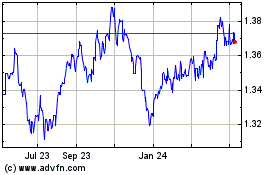Antipodean Currencies Rise Amid Risk Appetite
May 27 2024 - 11:00PM
RTTF2
Antipodean currencies such as the Australia and the New Zealand
dollars strengthened against their major currencies in the Asian
session on Tuesday amid risk appetite, following the broadly
positive cues from the European markets overnight, as traders
remain cautious ahead of key inflation readings from the U.S.,
Europe, Japan and Australia later in the week, which could help
traders access the timing and pace of interest rate cuts this
year.
Gains in mining and energy stocks amid firmer commodity prices,
also lifted the investor sentiment.
In economic news, data from the Australian Bureau of Statistics
showed that Australia's retail sales grew less than expected in
April, as consumers reduced their discretionary spending. Retail
turnover edged up 0.1 percent on a monthly basis, reversing a 0.4
percent fall in March. But the pace of growth was weaker than
economists' forecast of 0.3 percent.
In the Asian trading now, the Australian dollar rose to an 8-day
104.56 against the yen, from yesterday's closing value of 104.33.
The aussie may test resistance near the 105.00 region.
Against the U.S. and the Canadian dollars, the aussie advanced
to a 6-day high of 0.6674 and 0.9088 from Monday's closing quotes
of 0.6651 and 0.9067, respectively. If the aussie extends its
uptrend, it is likely to find resistance around 0.68 against the
greenback and 0.91 against the loonie.
Against the euro, the aussie edged up to 1.6300 from yesterday's
closing value of 1.6316. On the upside, 1.62 is seen as the next
resistance level for the aussie.
The NZ dollar rose to a 17-year high of 96.66 against the yen
and a 2-1/2-month high of 0.6166 against the U.S. dollar, from
Monday's closing quotes of 96.44 and 0.6148, respectively. If the
kiwi extends its uptrend, it is likely to find resistance around
97.00 against the yen and 0.62 against the greenback.
Against the euro and the Australian dollar, the kiwi advanced to
more than 2-1-2/month highs of 1.7633 and 1.0806 from yesterday's
closing quotes of 1.7650 and 1.0811, respectively. The kiwi may
test resistance near 1.75 against the euro and 1.07 against the
aussie.
Meanwhile, the safe-haven currency or the U.S. dollar fell
against its major rivals in the Asian session amid risk
appetite.
The U.S. dollar fell to an 8-day low of 1.0880 against the euro
and more than a 2-month high of 1.2784 against the pound, from
yesterday's closing quotes of 1.0857 and 1.2727, respectively. The
next possible downside target for the greenback is seen around 1.10
against the euro and 1.29 against the pound.
Against the yen, the Swiss franc and the Canadian dollar, the
greenback slipped to a 5-day low of 156.62, a 6-day low of 0.9117
and a 1-week low of 1.3614 from Monday's closing quotes of 156.81,
0.9133 and 1.3632, respectively. If the greenback extends its
downtrend, it is likely to find support around 152.00 against the
yen, 0.89 against the franc and 1.34 against the loonie.
Looking ahead, the Confederation of British Industry publishes
monthly Distributive Trades survey results at 6:00 am ET in the
European session.
In the New York session, Canada PPI and raw material prices for
April, U.S. house price index for March, U.S. Consumer Board's
consumer confidence for March and U.S. Dallas manufacturing index
for May are slated for release.
US Dollar vs CAD (FX:USDCAD)
Forex Chart
From May 2024 to Jun 2024

US Dollar vs CAD (FX:USDCAD)
Forex Chart
From Jun 2023 to Jun 2024
